OMG’s Issue Reporting Procedure
Preface
1 Scope
2 Conformance
2.1 Process Modeling Conformance
2.1.1 BPMN Process Types
2.1.2 BPMN Process Elements
2.1.3 Visual Appearance
2.1.4 Structural Conformance
2.1.5 Process Semantics
2.1.6 Attributes and Model Associations
2.1.7 Extended and Optional Elements
2.1.8 Visual Interchange
2.2 Process Execution Conformance
2.2.1 Execution Semantics
2.2.2 Import of Process Diagrams
2.3 BPEL Process Execution Conformance
2.4 Choreography Modeling Conformance
2.4.1 BPMN Choreography Types
2.4.2 BPMN Choreography elements
2.4.3 Visual Appearance
2.4.4 Choreography Semantics
2.4.5 Visual Interchange
2.5 Summary of BPMN Conformance Types
3 Normative References
3.1 Normative
3.2 Non-Normative
4 Terms and Definitions
5 Symbols
6 Additional Information
6.1 Conventions
6.1.1 Typographical and Linguistic Conventions and Style
6.1.2 Abbreviations
6.2 Structure of this Document
6.3 Acknowledgements
7 Overview
7.1 BPMN Scope
7.1.1 Uses of BPMN
7.2 BPMN Elements
7.2.1 Basic BPMN Modeling Elements
7.2.2 Extended BPMN Modeling Elements
7.3 BPMN Diagram Types
7.4 Use of Text, Color, Size, and Lines in a Diagram
7.5 Flow Object Connection Rules
7.5.1 Sequence Flow Connections Rules
7.5.2 Message Flow Connection Rules
7.6 BPMN Extensibility
7.7 BPMN Example
8 BPMN Core Structure
8.1 Infrastructure
8.1.1 Definitions
8.1.2 Import
8.1.3 Infrastructure Package XML Schemas
8.2 Foundation
8.2.1 Base Element
8.2.2 Documentation
8.2.3 Extensibility
8.2.4 External Relationships
8.2.5 Root Element
8.2.6 Foundation Package XML Schemas
8.3 Common Elements
8.3.1 Artifacts
8.3.2 Correlation
8.3.3 Error
8.3.4 Escalation
8.3.5 Events
8.3.6 Expressions
8.3.7 Flow Element
8.3.8 Flow Elements Container
8.3.9 Gateways
8.3.10 Item Definition
8.3.11 Message
8.3.12 Resources
8.3.13 Sequence Flow
8.3.14 Common Package XML Schemas
8.4 Services
8.4.1 Interface
8.4.2 EndPoint
8.4.3 Operation
8.4.4 Service Package XML Schemas
9 Collaboration
9.1 Basic Collaboration Concepts
9.1.1 Use of BPMN Common Elements
9.2 Pool and Participant
9.2.1 Participants
9.2.2 Lanes
9.3 Message Flow
9.3.1 Interaction Node
9.3.2 Message Flow Associations
9.4 Conversations
9.4.1 Conversation Node
9.4.2 Conversation
9.4.3 Sub-Conversation
9.4.4 Call Conversation
9.4.5 Global Conversation
9.4.6 Conversation Link
9.4.7 Conversation Association
9.4.8 Correlations
9.5 Process Within Collaboration
9.6 Choreography within Collaboration
9.7 Collaboration Package XML Schemas
10 Process
10.1 Basic Process Concepts
10.1.1 Types of BPMN Processes
10.1.2 Use of BPMN Common Elements
10.2 Activities
10.2.1 Resource Assignment
10.2.2 Performer
10.2.3 Tasks
10.2.4 Human Interactions
10.2.5 Sub-Processes
10.2.6 Call Activity
10.2.7 Global Task
10.2.8 Loop Characteristics
10.2.9 XML Schema for Activities
10.3 Items and Data
10.3.1 Data Modeling
10.3.2 Execution Semantics for Data
10.3.3 Usage of Data in XPath Expressions
10.3.4 XML Schema for Data
10.4 Events
10.4.1 Concepts
10.4.2 Start Event
10.4.3 End Event
10.4.4 Intermediate Event
10.4.5 Event Definitions
10.4.6 Handling Events
10.4.7 Scopes
10.4.8 Events Package XML Schemas
10.5 Gateways
10.5.1 Sequence Flow Considerations
10.5.2 Exclusive Gateway
10.5.3 Inclusive Gateway
10.5.4 Parallel Gateway
10.5.5 Complex Gateway
10.5.6 Event-Based Gateway
10.5.7 Gateway Package XML Schemas
10.6 Compensation
10.6.1 Compensation Handler
10.6.2 Compensation Triggering
10.6.3 Relationship between Error Handling and Compensation
10.7 Lanes
10.8 Process Instances, Unmodeled Activities, and Public Processes
10.9 Auditing
10.10 Monitoring
10.11 Process Package XML Schemas
11 Choreography
11.1 Basic Choreography Concepts
11.2 Data
11.3 Use of BPMN Common Elements
11.3.1 Sequence Flow
11.3.2 Artifacts
11.4 Choreography Activities
11.4.1 Choreography Task
11.4.2 Sub-Choreography
11.4.3 Call Choreography
11.4.4 Global Choreography Task
11.4.5 Looping Activities
11.4.6 The Sequencing of Activities
11.5 Events
11.5.1 Start Events
11.5.2 Intermediate Events
11.5.3 End Events
11.6 Gateways
11.6.1 Exclusive Gateway
11.6.2 Event-Based Gateway
11.6.3 Inclusive Gateway
11.6.4 Parallel Gateway
11.6.5 Complex Gateway
11.6.6 Chaining Gateways
11.7 Choreography within Collaboration
11.7.1 Participants
11.7.2 Swimlanes
11.8 XML Schema for Choreography
12 BPMN Notation and Diagrams
12.1 BPMN Diagram Interchange (BPMN DI)
12.1.1 Scope
12.1.2 Diagram Definition and Interchange
12.1.3 How to Read this Chapter
12.2 BPMN Diagram Interchange (DI) Meta-model
12.2.1 Overview
12.2.2 Abstract Syntax
12.2.3 Classifier Descriptions
12.2.4 Complete BPMN DI XML Schema
12.3 Notational Depiction Library and Abstract Element Resolutions
12.3.1 Labels
12.3.2 BPMNShape
12.3.3 BPMNEdge
12.4 Example(s)
12.4.1 Depicting Content in a Sub-Process
12.4.2 Multiple Lanes and Nested Lanes
12.4.3 Vertical Collaboration
12.4.4 Conversation
12.4.5 Choreography
13 BPMN Execution Semantics
13.1 Process Instantiation and Termination
13.2 Activities
13.2.1 Sequence Flow Considerations
13.2.2 Activity
13.2.3 Task
13.2.4 Sub-Process/Call Activity
13.2.5 Ad-Hoc Sub-Process
13.2.6 Loop Activity
13.2.7 Multiple Instances Activity
13.3 Gateways
13.3.1 Parallel Gateway (Fork and Join)
13.3.2 Exclusive Gateway (Exclusive Decision (data-based) and Exclusive Merge)
13.3.3 Inclusive Gateway (Inclusive Decision and Inclusive Merge)
13.3.4 Event-based Gateway (Exclusive Decision (event-based))
13.3.5 Complex Gateway (related to Complex Condition and Complex Merge)
13.4 Events
13.4.1 Start Events
13.4.2 Intermediate Events
13.4.3 Intermediate Boundary Events
13.4.4 Event Sub-Processes
13.4.5 Compensation
13.4.6 End Events
14 Mapping BPMN Models to WS-BPEL
14.1 Basic BPMN-BPEL Mapping
14.1.1 Process
14.1.2 Activities
14.1.3 Events
14.1.4 Gateways and Sequence Flows
14.1.5 Handling Data
14.2 Extended BPMN-BPEL Mapping
14.2.1 End Events
14.2.2 Loop/Switch Combinations From a Gateway
14.2.3 Interleaved Loops
14.2.4 Infinite Loops
14.2.5 BPMN Elements that Span Multiple WSBPEL Sub-Elements
15 Exchange Formats
15.1 Interchanging Incomplete Models
15.2 Machine Readable Files
15.3 XSD
15.3.1 Document Structure
15.3.2 References within the BPMN XSD
15.4 XMI
15.5 XSLT Transformation between XSD and XMI
Annex A: Changes from v1.2
Annex B: Diagram Interchange
B.1 Scope
B.2 Architecture
B.3 Diagram Common
B.3.1 Overview
B.3.2 Abstract Syntax
B.3.3 Classifier Descriptions
B.4 Diagram Interchange
B.4.1 Overview
B.4.2 Abstract Syntax
B.4.3 Classifier Descriptions
Annex C: Glossary
(informative)
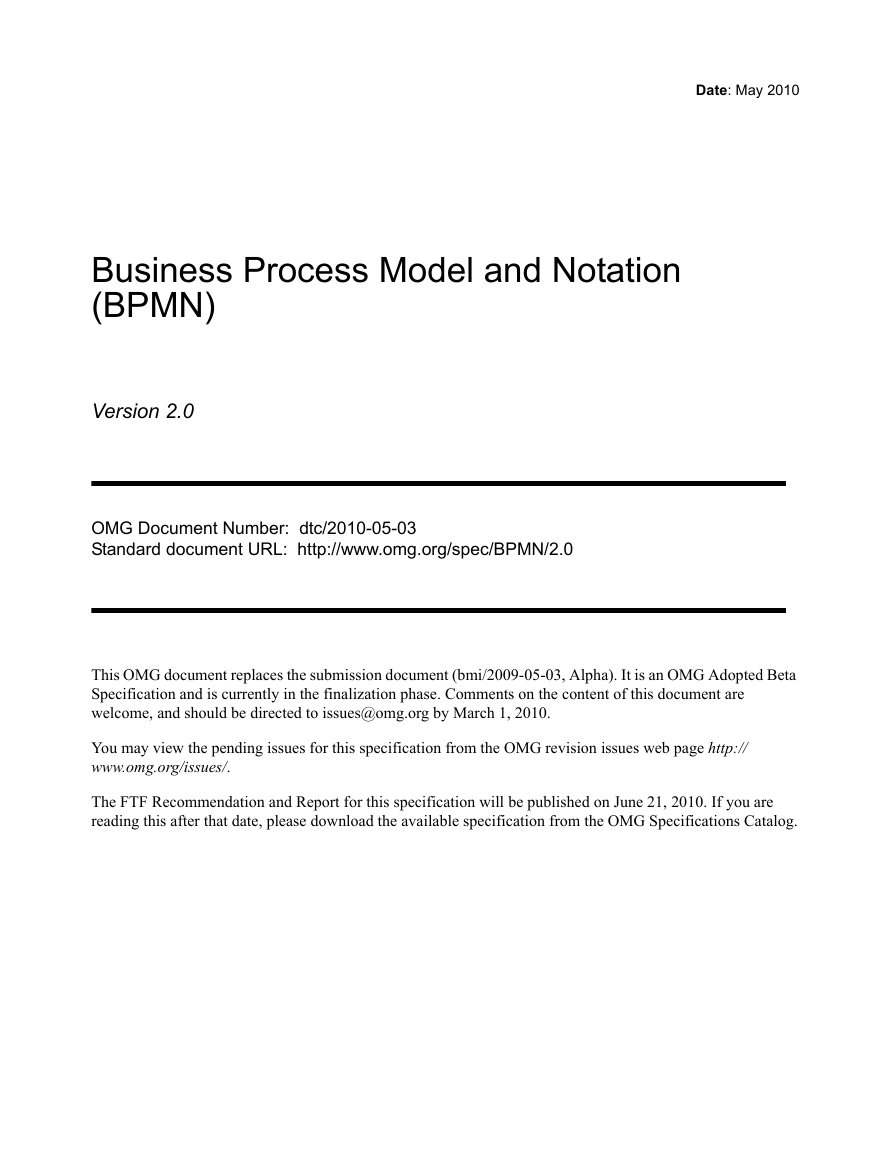
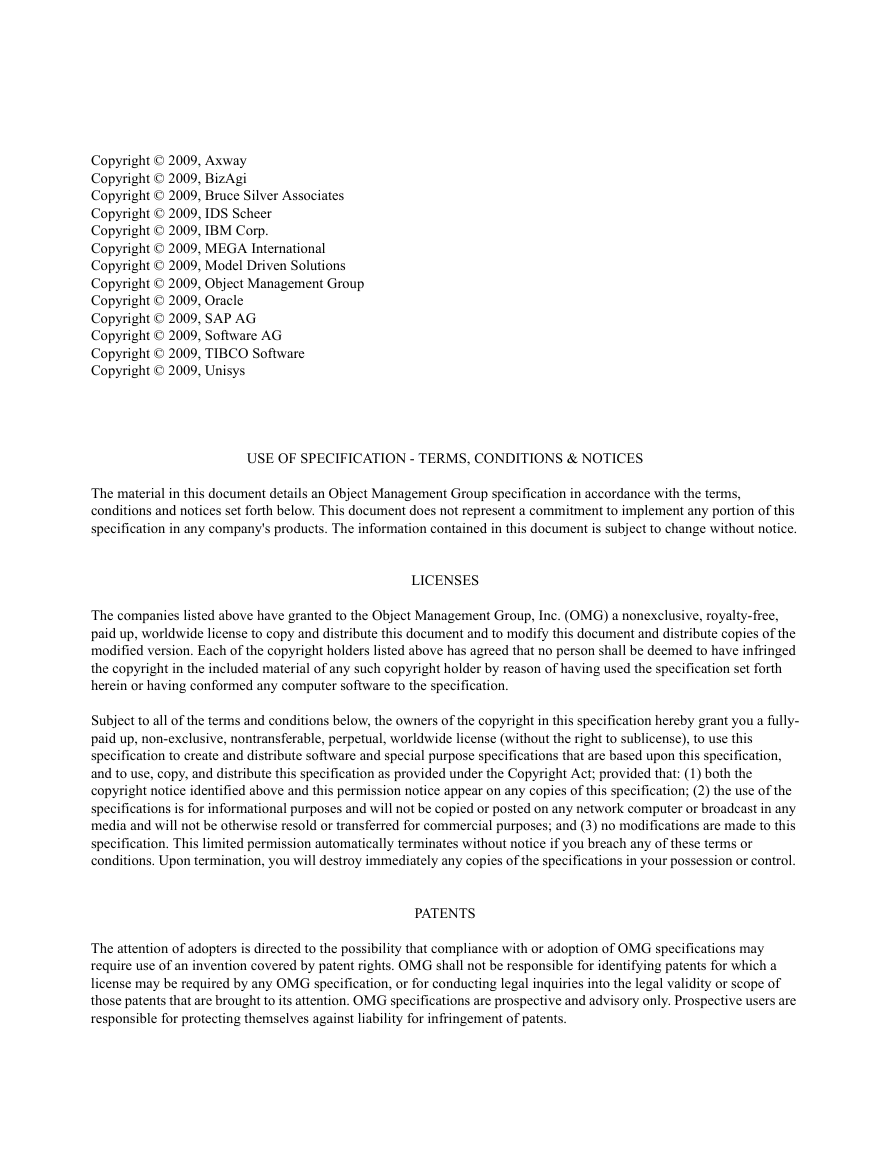
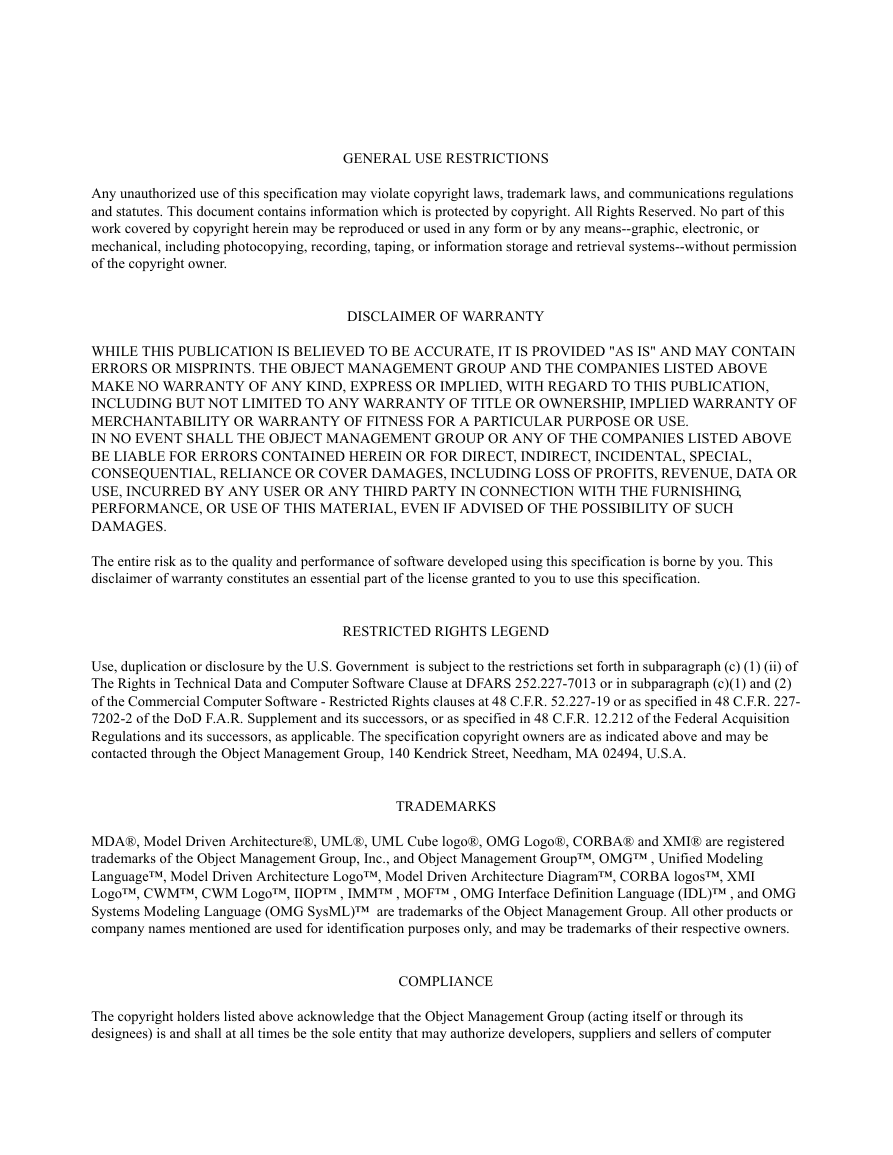
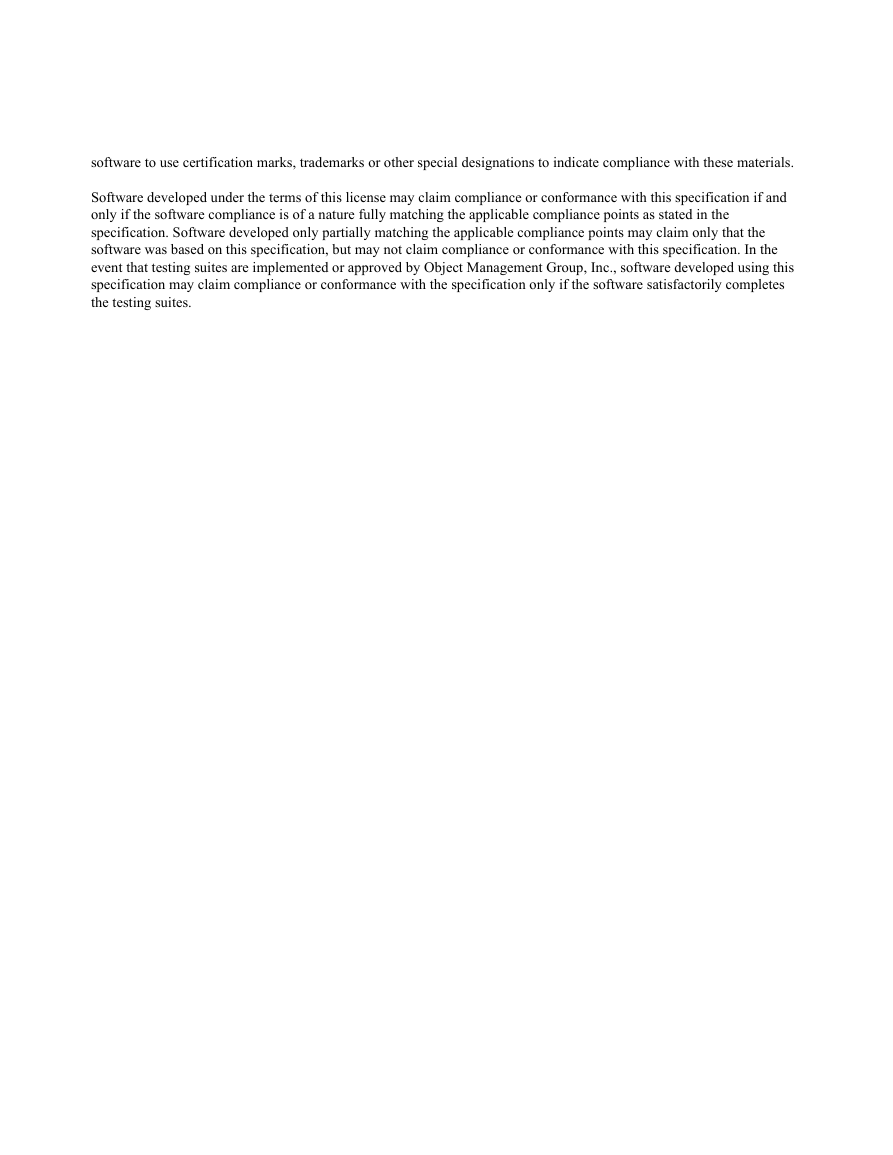
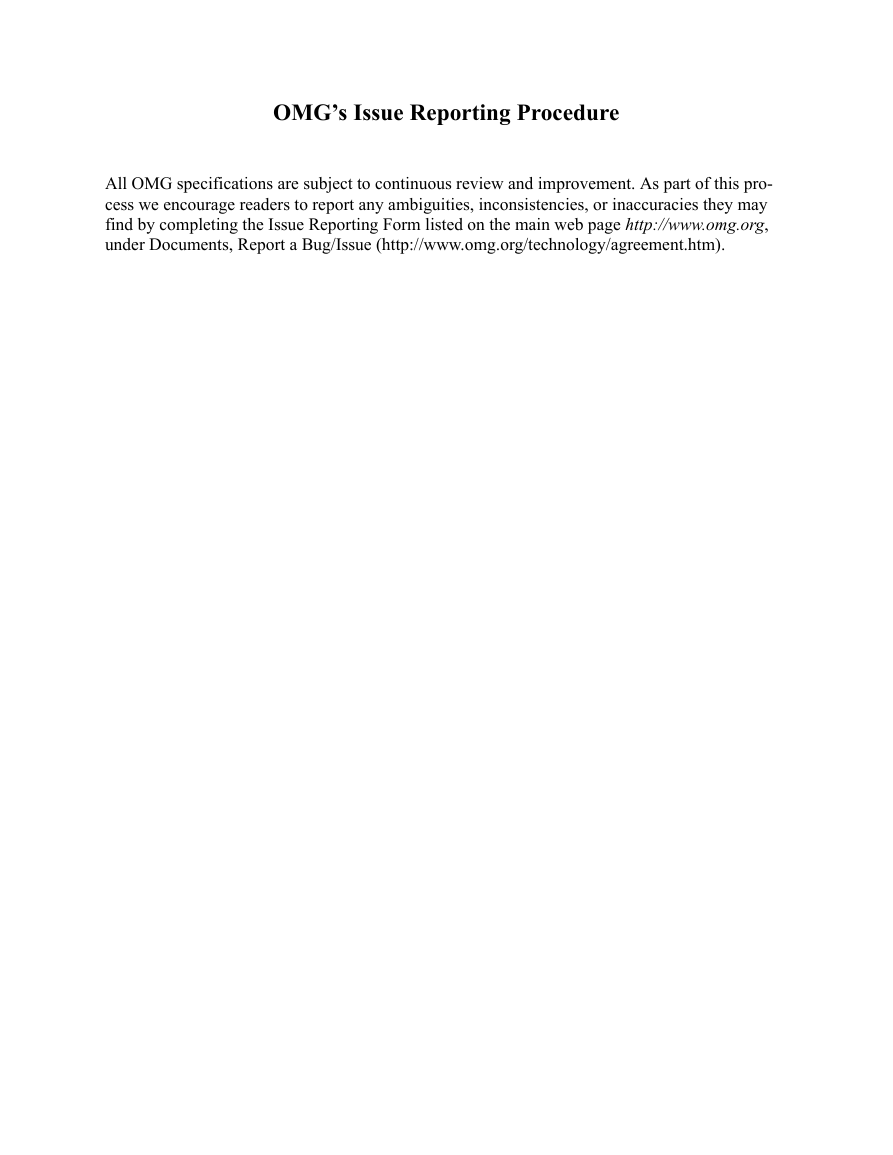











 2023年江西萍乡中考道德与法治真题及答案.doc
2023年江西萍乡中考道德与法治真题及答案.doc 2012年重庆南川中考生物真题及答案.doc
2012年重庆南川中考生物真题及答案.doc 2013年江西师范大学地理学综合及文艺理论基础考研真题.doc
2013年江西师范大学地理学综合及文艺理论基础考研真题.doc 2020年四川甘孜小升初语文真题及答案I卷.doc
2020年四川甘孜小升初语文真题及答案I卷.doc 2020年注册岩土工程师专业基础考试真题及答案.doc
2020年注册岩土工程师专业基础考试真题及答案.doc 2023-2024学年福建省厦门市九年级上学期数学月考试题及答案.doc
2023-2024学年福建省厦门市九年级上学期数学月考试题及答案.doc 2021-2022学年辽宁省沈阳市大东区九年级上学期语文期末试题及答案.doc
2021-2022学年辽宁省沈阳市大东区九年级上学期语文期末试题及答案.doc 2022-2023学年北京东城区初三第一学期物理期末试卷及答案.doc
2022-2023学年北京东城区初三第一学期物理期末试卷及答案.doc 2018上半年江西教师资格初中地理学科知识与教学能力真题及答案.doc
2018上半年江西教师资格初中地理学科知识与教学能力真题及答案.doc 2012年河北国家公务员申论考试真题及答案-省级.doc
2012年河北国家公务员申论考试真题及答案-省级.doc 2020-2021学年江苏省扬州市江都区邵樊片九年级上学期数学第一次质量检测试题及答案.doc
2020-2021学年江苏省扬州市江都区邵樊片九年级上学期数学第一次质量检测试题及答案.doc 2022下半年黑龙江教师资格证中学综合素质真题及答案.doc
2022下半年黑龙江教师资格证中学综合素质真题及答案.doc